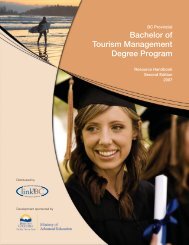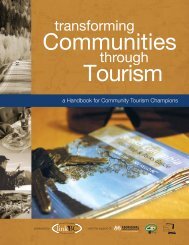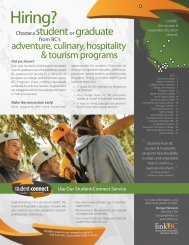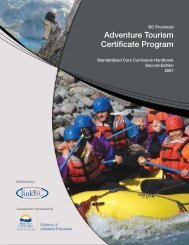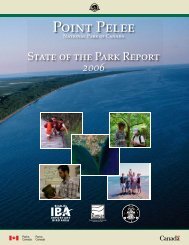Cultural Heritage Tourism Handbook - LinkBC
Cultural Heritage Tourism Handbook - LinkBC
Cultural Heritage Tourism Handbook - LinkBC
- No tags were found...
You also want an ePaper? Increase the reach of your titles
YUMPU automatically turns print PDFs into web optimized ePapers that Google loves.
Tips for Creating Visitor-Friendly ItinerariesTheme Example: Mountains, Ranchers and OilmenThe Epic Alberta, Historic Places Road Trip Guide illustrates somestrong cultural themes. It is founded on the understandingthat “encounters between people and the land have resultedin a rich and diverse collectionof cultural resourcesthat define Alberta’s distinctsense of place.” 45A good example is one of the 12regions profiled, featuring a Mountains,Ranchers and Oilmen theme, whichincludes an historical overview ofthe area, effective descriptors, andphotos. Together these resources linka wide range of regional attractionsfrom the Royal Tyrell Museum, to theMcDougall Memorial United Church,and from Okotoks Erratic “Big Rock” tothe Stephen Avenue National HistoricDistrict in Calgary.Themed routes and itineraries addvalue because they make it easy for visitors to plan their vacation and expose themto things they may enjoy but not have found on their own. They can serve as a strongtool to increase visitation and extend visitor stays.Creating Themed Itineraries in Your CommunityThis list was adapted from <strong>Cultural</strong> <strong>Heritage</strong> <strong>Tourism</strong>: Practical Applications: Museum Associationof Arizona 46 . They suggest your community creates itineraries with the following features:£ £ Realistic Times. Have a realistic understanding of the time ittakes to visit the recommended cultural/heritage experiences,and share this with visitors. Generally, an hour is a long timefor most people to spend in any single attraction. If any ofyour attractions require more time, say so. Make sure there isminimal driving time between points of interest on the route.£ £ Appropriate Length. When designing itineraries, it’s best towrite a variety of timeframes including half-day tours, overnighttours, and, if possible, link up with neighbouring destinationsand lodging partners to create a weekend (two or three-day)excursion.£ £ Great Map. Make sure an easy-to-use road and tourist mapis provided. Include cultural highlights, messages from yourinterpretive program, and all relevant travel and road information.Use the map to promote the services of business partners.£ £ Clear Information. Give accurate directions to attractions onthe route. Provide accurate information about days/hours ofoperation and entrance fees.£ £ Appealing Descriptions. Briefly describe the highlights ofwhat the visitor will discover, but don’t oversell an attractionor experience. It’s better to “under-promise” and “over-deliver”.£ £ Roads and Driving Information. Be honest about drivingtime, road conditions, and provide information about gas andfood-stop opportunities.£ £ Tips for Your Target Market. Include the type of informationyour target market needs to know. Is this a good place forchildren to enjoy? Is there a cafe on premise or nearby? Canyou bring a picnic lunch and enjoy it on the grounds? Do youneed to wear comfortable shoes to enjoy your attraction? Isany special clothing needed?£ £ Accessible <strong>Tourism</strong>. Include attractions and experiences thataccommodate travellers with disabilities and highlight thesefeatures (wheelchair accessible trails, etc.).£ £ Where to Stay and Eat. For itineraries longer than half aday, add recommendations about where to stay and eat.Incorporate unique local cuisine and specialties.£ £ Ways to Engage Visitors. The most successful itinerariesprovide opportunities for people to interact with local guides,ponder the exhibits, internalize the messages, and marvel atthe natural scenery.Inter-Connections Lead to StoriesAlthough each cultural/heritage tourism experience can be assignedto a specific cultural tourism cluster (such as “Cuisine”), culture itself,as Thorne notes, “is a web of interconnectivity. For example, cuisineis connected to agricultural heritage and to natural history. Cuisineis also an art.”Once communities have identified the interconnections amongthe experiences they have inventoried, Thorne recommends thatnarratives and stories then be developed to showcase these interconnections,highlight the destination’s themes, and promote adistinctive sense of place.The next case study illustrates how seemingly disparate communitiesand stakeholder groups can come together under a common bannerto present a web of cultural/heritage experiences that create senseof place for visitors.To create one in your community, your task force, or individual members, can startby researching and the best attractions in your destination. Build appealing themedroutes around core experiences, geographic areas, cultural themes, or visitor interests.Don’t forget to highlight scenic values and natural assets on the route. For inspiration,think back to the network of PEI driving tours featured in the Arts and <strong>Heritage</strong> Trailpromotion (described in the last chapter).Once itineraries are developed, feature them on your website and in other collateralto showcase the great things to see and do in your area. Have all task force marketingpartners promote these options to help encourage visitation and longer stays.64 65



